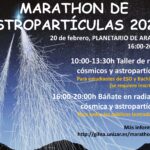PhD position in Direct Dark Matter Search with Liquid Argon Detectors
The Dark Matter research group (CIEMAT-DM) of the CIEMAT-FP Unit (Centre for Research in Energy, Environment and Technology in Madrid, Spain) announces the upcoming opening of a predoctoral position for outstanding young MSc graduates interested in working in direct Dark Matter search activities towards a PhD Thesis. The 4-year PhD contract is funded by CIEMAT. […]




